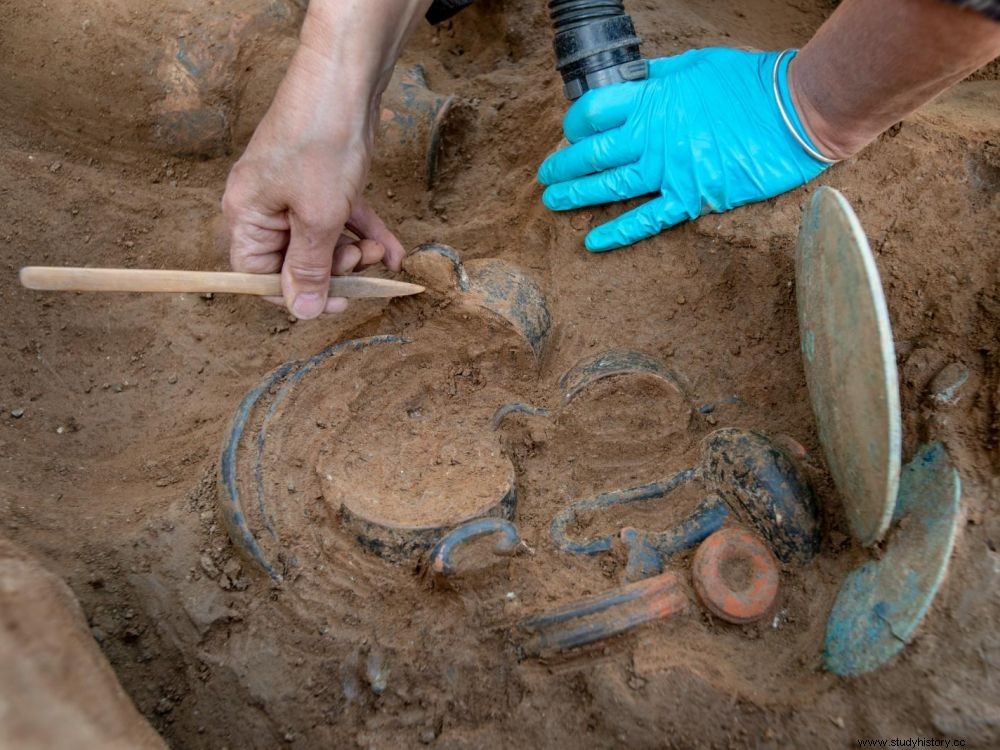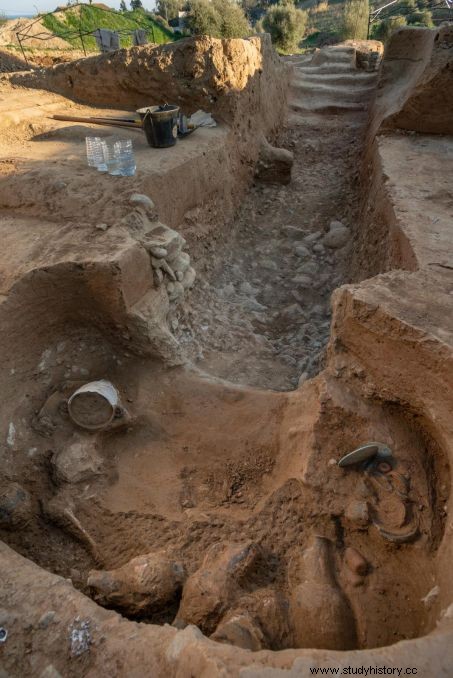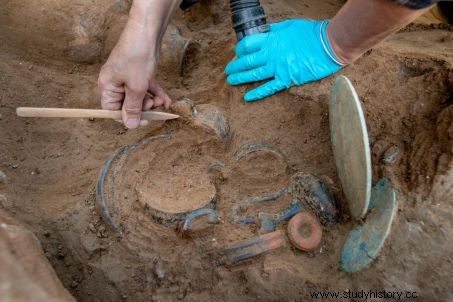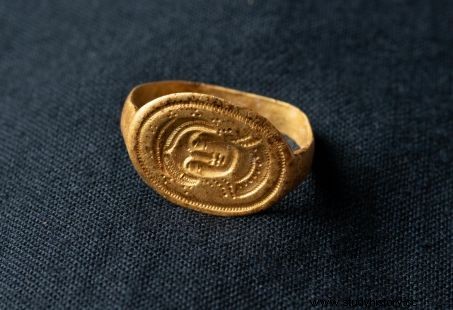Opened only a few days ago, an Etruscan burial chamber located under a necropolis from the Roman era, in the region of Aleria, in Corsica, could teach us more about this little-known civilization. Report.

The Etruscan tomb of the archaeological site of Aleria, at a place called Lamajone, in Corsica.
If the rain is rare in Corsica, we can say that it was there on Tuesday March 26, 2019, the day of the presentation to the press of a rare Etruscan tomb, discovered on the archaeological site of Aleria, instead -said Lamajone, an hour's drive from Bastia. It is with their feet in the mud that the archaeologists, anxious to protect the precious vestiges from the drops, presented to us the vault, whose occupant and his funerary objects have just seen the light of day, after more than 2350 years. passed buried underground.

Overview of the excavation of the Etruscan tomb (Denis Gliskman/Inrap).
A first since the 1960s
For nearly 50 years, that is to say since the last excavations of the necropolis of Casabianda, a few hundred meters from the current site, by Jean Jehasse, no Etruscan tomb had been discovered in Corsica. It could also have remained sealed for a long time, if an individual had not wished to build a house on his land. The suspected presence of remains then mobilized a team of researchers from Inrap (National Institute for Preventive Archaeological Research) in June 2018. They quickly come across a necropolis from the Roman era with 130 intertwined burials, in a remarkable state of preservation.
But among these tombs, they also discover some steps leading deeper underground, leading them to think that a hypogeum – an underground burial – Etruscan, and therefore older than the surrounding tombs, is still hidden under their feet. "The tomb itself is not exceptional. What is especially the fact of having the opportunity to explore a new one with the advanced techniques that we have at our disposal today' today", explains Laurent Vidal, scientific manager at Inrap and in situ research .
A meticulous search protocol
Because this tomb is indeed the oldest, it will be the last to be explored. Archaeologists recently discovered that his flight of stairs led to a long corridor six meters long giving access to his burial chamber. "We started his search only a few days ago", reports Laurent Vidal. "So at the moment, we know very little about its contents, of which we have only cleaned a small part" .
Because removing the objects from such an ancient tomb, currently estimated at 350-300 BC, requires a lot of precautions, at the risk of seeing the paint on the ceramics chipping off or certain pieces falling into dust during their shift. "We must consolidate the remains as they are discovered. It is a delicate operation given the changing climatic conditions and the inevitable trauma that the passage of a state represents in itself for the objects ' earthy' to an 'airy' state", says Marina Biron, conservator-restorer at Inrap.

On the right, metal disks that could correspond to a mirror (Denis Gliskman/Inrap).
Many unknowns
At this stage of the excavations, it is therefore difficult to advance on the sex or even the social rank of the dead. "What we know is that he is buried alone, that he is positioned on his left side with his head to the east, and that different types of vases have been placed at his side " , explains Laurent Vidal. "Perhaps there is also a mirror with its case, but it's a little early to say for sure".
For the moment, only the skull of the deceased and his right shoulder have been released. The remaining fifteen days of excavation at the site should allow archaeologists to unearth the entire skeleton and perhaps, they hope, some jewelry. And they have reason to expect to find some:a few meters from the tomb, a small gold ring "possibly Etruscan, given the characteristic female figure it presents" , was found in a ditch. Other gold rings or earrings were scattered in the many adjacent Roman tombs. In total, the burial chamber of approximately one square meter yielded several artefacts, including three black-varnished goblets, two skyphoi (kinds of goblets with handles), the handle of a probable oinochoe (a kind of wine pitcher ), and what could therefore be a mirror.

The small gold ring found in a ditch near the tomb (Denis Gliskman/Inrap).
For Dominique Garcia, president of Inrap, "this discovery puts a spotlight on the exceptional site that is Aleria" . It is also the first in the region for which so many resources – nearly 1.5 million euros – have been deployed by the State. Never has Corsica been so dynamic as today in terms of archaeological excavations:no less than four sites are being excavated there. But to know if the Etruscan tomb of Lamajone really stands out, we will have to wait a few more weeks, the time it will take for the experts to make his death speak.
